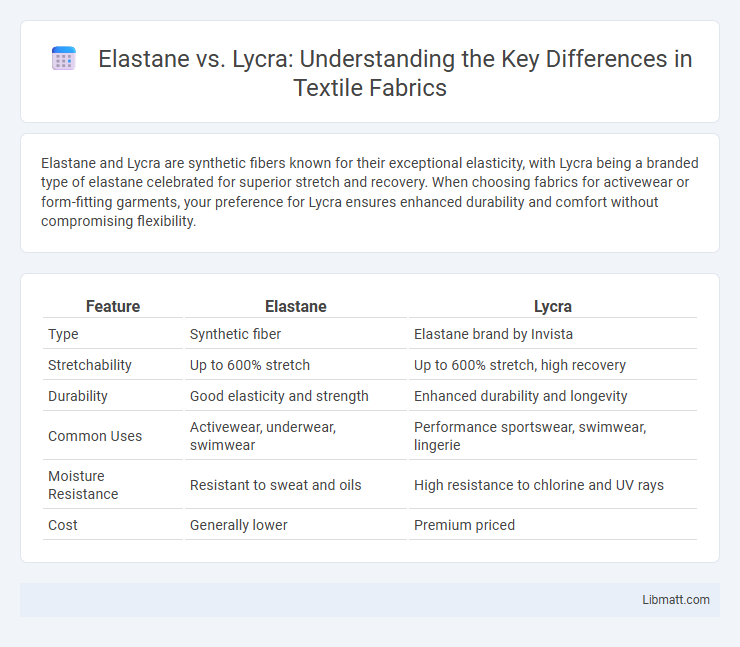Elastane and Lycra are synthetic fibers known for their exceptional elasticity, with Lycra being a branded type of elastane celebrated for superior stretch and recovery. When choosing fabrics for activewear or form-fitting garments, your preference for Lycra ensures enhanced durability and comfort without compromising flexibility.
Table of Comparison
| Feature | Elastane | Lycra |
|---|---|---|
| Type | Synthetic fiber | Elastane brand by Invista |
| Stretchability | Up to 600% stretch | Up to 600% stretch, high recovery |
| Durability | Good elasticity and strength | Enhanced durability and longevity |
| Common Uses | Activewear, underwear, swimwear | Performance sportswear, swimwear, lingerie |
| Moisture Resistance | Resistant to sweat and oils | High resistance to chlorine and UV rays |
| Cost | Generally lower | Premium priced |
Introduction to Elastane and Lycra
Elastane and Lycra are synthetic fibers known for their exceptional elasticity, commonly used in sportswear, activewear, and stretchable clothing. Elastane is a generic term for a fiber that can stretch up to five times its original length while retaining shape, whereas Lycra is a brand name of elastane produced by Invista, renowned for superior durability and comfort. Understanding the difference between Elastane and Lycra helps you choose high-performance fabrics tailored to your specific needs.
What is Elastane?
Elastane is a synthetic fiber known for its exceptional elasticity, often comprising 10-15% of fabric blends to provide stretch and durability. It is a generic term used primarily in Europe and Asia, synonymous with Lycra, which is a trademarked brand owned by Invista. Elastane fibers can stretch up to five times their original length, making them ideal for activewear, swimwear, and form-fitting garments that require flexibility and shape retention.
What is Lycra?
Lycra is a brand name for a type of elastane fiber known for its exceptional stretch and recovery properties, commonly used in activewear, swimwear, and underwear. It is a synthetic fiber made from polyurethane, providing garments with elasticity, durability, and comfort. Lycra enhances fabric performance by allowing for greater flexibility and shape retention compared to traditional materials.
Elastane vs Lycra: Key Differences
Elastane and Lycra are essentially the same synthetic fiber known for exceptional stretch and recovery properties, used widely in activewear and fashion. Lycra is a brand name for elastane, often carrying a reputation for higher quality and durability in fabric performance. Your choice between elastane and Lycra often comes down to brand preference and specific fabric blends, as both provide superior elasticity.
Similarities Between Elastane and Lycra
Elastane and Lycra are synthetic fibers known for their exceptional elasticity and ability to stretch up to five times their original length, making them ideal for activewear and form-fitting garments. Both fibers enhance fabric durability, moisture-wicking properties, and comfort by providing a snug, flexible fit that maintains shape retention. Commonly blended with natural fibers like cotton and wool, elastane and Lycra improve garment performance without compromising softness or breathability.
Common Uses in Fashion and Sportswear
Elastane and Lycra are widely used in fashion and sportswear for their exceptional stretch and recovery properties. Elastane is commonly found in activewear, swimwear, and leggings, providing flexibility and comfort during physical activities. Lycra, a branded form of elastane, is favored in high-performance sportswear and shapewear due to its superior elasticity and durability.
Durability and Performance Comparison
Elastane and Lycra, both known for exceptional stretch and recovery, differ slightly in durability due to Lycra being a trademarked, high-quality form of elastane designed for enhanced performance in activewear. Elastane offers strong resistance to wear and tear, but Lycra consistently provides superior shape retention and resilience under repeated stress, making it ideal for sports and fitness apparel. Your choice between these fibers impacts the longevity and elasticity of garments, especially in high-intensity usage scenarios.
Pros and Cons of Elastane
Elastane, known for its exceptional elasticity, provides superior stretch and recovery, making it ideal for activewear and form-fitting clothing. Its advantages include durability, moisture resistance, and the ability to retain shape over time, though it can sometimes cause skin irritation for sensitive users and may degrade with excessive heat exposure. Your choice depends on prioritizing comfort and flexibility against potential sensitivity and care requirements.
Pros and Cons of Lycra
Lycra offers exceptional stretch and recovery, enhancing comfort and freedom of movement in activewear and swimwear. Its durability and resistance to sweat and chlorine make it ideal for prolonged use, though it may cause less breathability compared to natural fibers. Your choice of Lycra can improve garment fit and flexibility but might require careful washing to maintain elasticity and longevity.
Which One Should You Choose?
Elastane and Lycra both offer exceptional stretch and durability, with Lycra being a branded form of elastane known for superior elasticity and resistance to wear. Choose Elastane for cost-effective, flexible fabric blends suitable for everyday wear, while Lycra is ideal for performance-oriented activewear and swimwear that demand enhanced shape retention and comfort. Prioritize Lycra when durability and sustained stretch are critical, but Elastane provides adequate performance for standard garment elasticity needs.
Elastane vs Lycra Infographic

 libmatt.com
libmatt.com